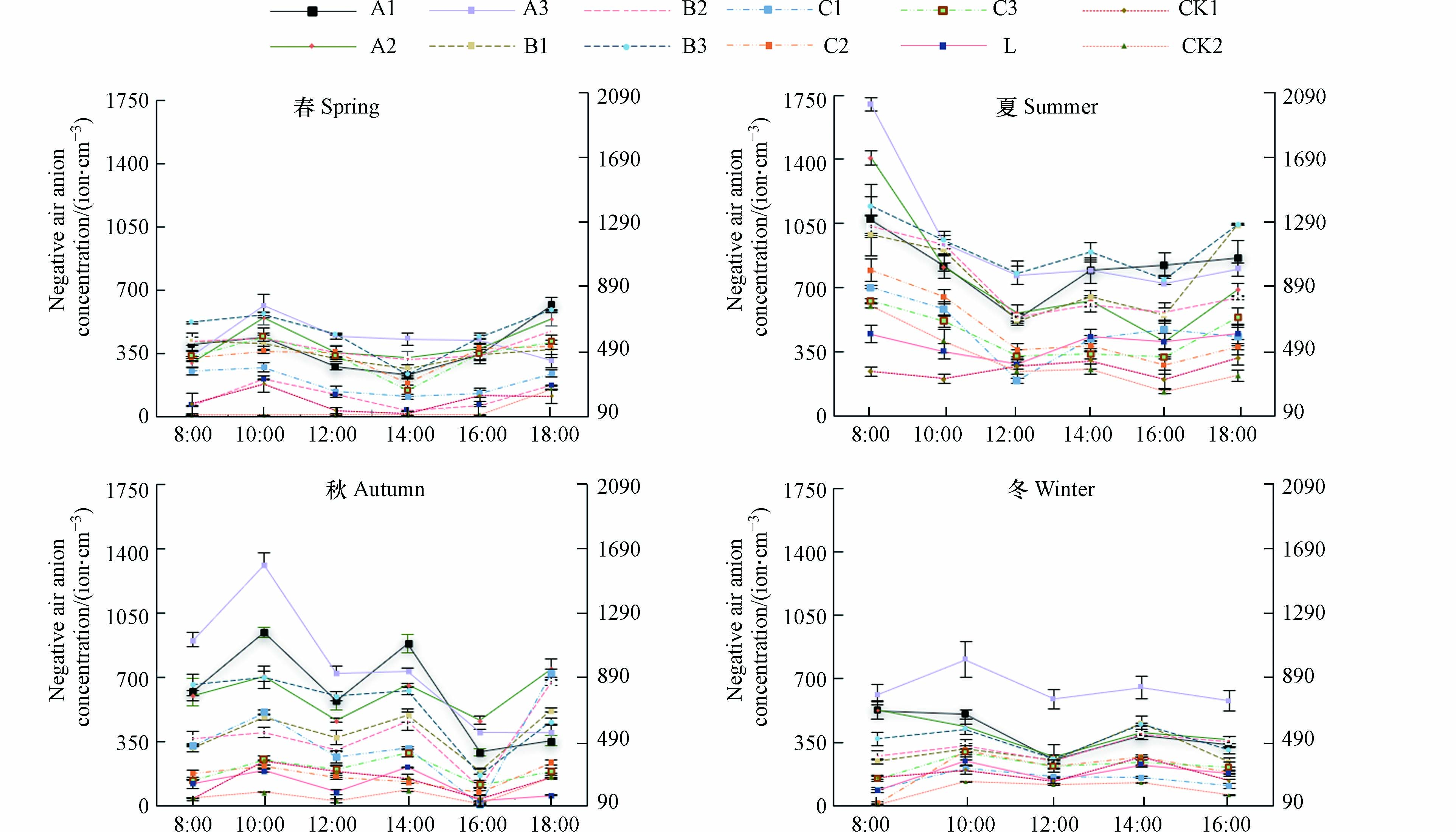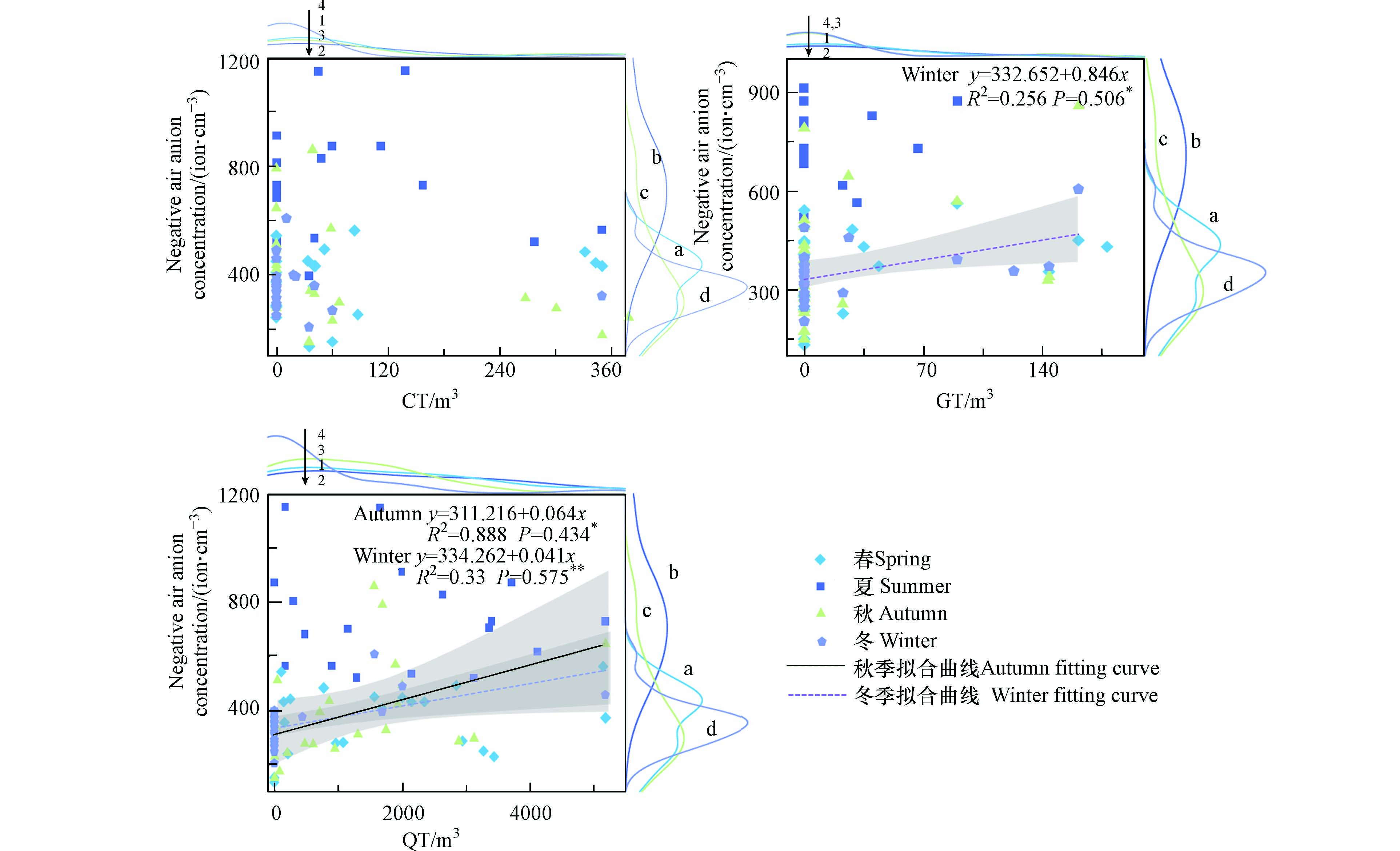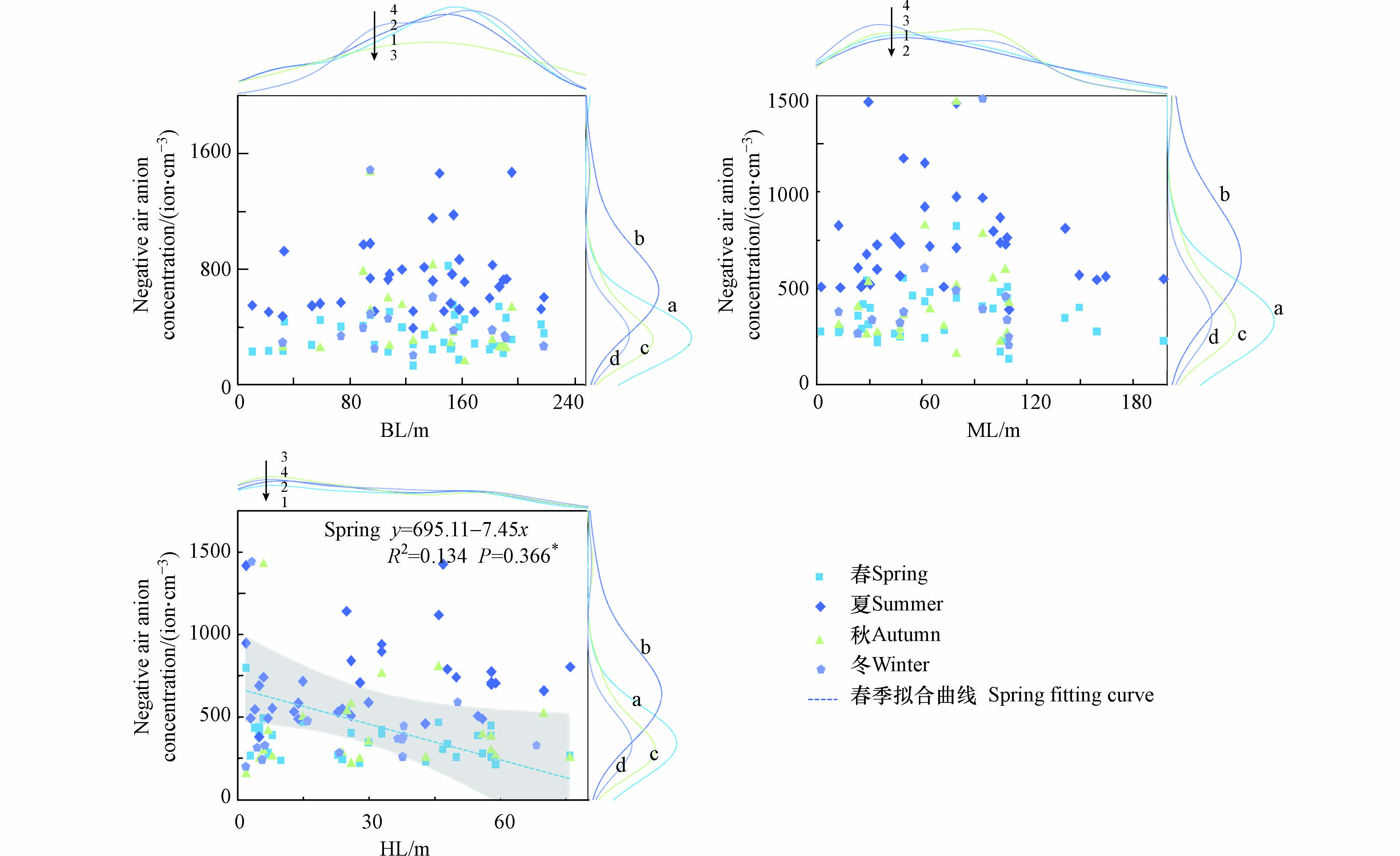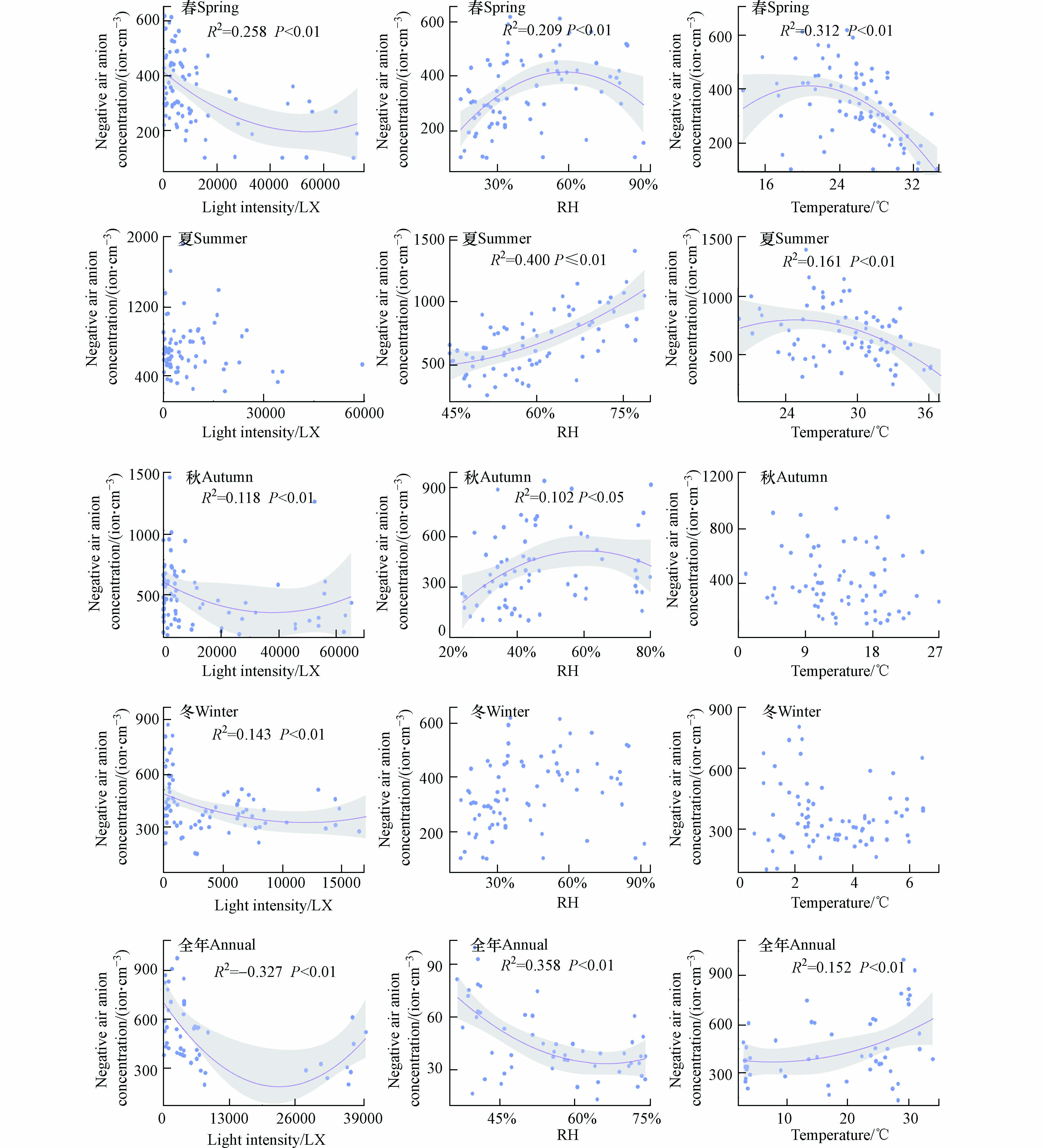-
空气负离子(NAI)是指由于空气中氧分子优先获得多余电子后带负电荷的空气离子[1]. NAI广泛分布在自然环境中,尤以森林和湿地较为突出[2]. 目前NAI被用作评价给定区域的生态服务的重要指标,被称为“空气维生素”[3-5]. NAI的产生和影响因素非常复杂多变,主要来源于植物效应、Lenard效应、放射性物质诱导等[6-14]. 另外,NAI浓度受水源的距离影响表现出一定的差异性[15].
湿地作为三大生态系统之一,被誉为“地球之肾”[16],为人类提供多种不可替代的生态产品. 自20世纪50年代以来,广泛开展了对湿地的研究工作,如湿地的分类、性质和功能等[17-18]. 但针对湿地生态系统NAI浓度的研究相对较少[19]. 仅有研究集中于湿地NAI浓度变化特征及空间分布等方面的研究[20-21],其中影响因子仅涉及林型、林地面积、湿地大小、距水体远近及空气相对湿度、温度、水汽压等[22-25],而针对植物群落的生物特征(如株高、冠幅、绿量、灌木体积等)、地理特征(如距公园边缘距离、距山体距离等)和光照强度与NAI浓度的相关性研究尚未报道;且相关研究未涉及综合特征因子(植物特征、地理因子、环境因子)对湿地公园四季NAI浓度影响的研究[26-27],本文以花溪湿地公园为研究对象,综合考虑城市湿地公园不同植物群落自身结构特征和地理特性、环境因子等多个影响因素,量化城市湿地公园NAI浓度的日变化和季节变化特征,明确植物群落与NAI浓度空间分布的相关关系,研究结论可以为量化评价城市湿地公园的微气候环境效应提供理论基础.
-
花溪十里河滩国家城市湿地公园以十里河滩(牛角岛至花溪大桥段:(106°40′23.4″—106°40′59.129″E, 26°26′20.9″—26°27′55.463″N)为主要调查区域, 全长2.8 km. 研究区属于亚热带湿润气候区,冬无严寒,夏无酷暑,气候温和湿润;年平均气温14.9 °C. 植物资源丰富,园内有维管束植物495种,其中湿地高等植物51种,占贵州省内湿地高等植物总数(185种)的27.6%. 湿地景观资源以人工林为主,生长状况良好,主要乔木树种有水杉(Metasequoia glyptostroboides )、桃(Amygdalus persica)、银杏(Ginkgo biloba )、桂花(Osmanthus fragrans)、广玉兰(Magnolia Grandiflora)、樱花(Prunus subg)等. 主要灌木树种有红叶石楠 (Photinia × fraseri )、海桐(Pittosporum tobira)、南天竹(Nandina domestica)、八角金盘(Fatsia japonica)等,主要地被植物有黑麦草(Lolium perenne)、早熟禾(Poa annua)、鸢尾(Iris tectorum)、唐菖蒲(Gladiolus × gandavensis)、白车轴草(Trifolium repens)、黄金菊(Euryops pectinatus)等.
-
在花溪十里河滩国家城市湿地公园内采用瑞典学派典型样方法[6],选定35处位点作为监测点,样点布设以不同的植被类型(常绿群落(A)、落叶群落(B)、水边群落(C))和群落结构(乔灌草(1)、乔灌(2)、乔(3))为主要考虑因素,每种样地类型设置3组重复. 设置20 m×20 m的乔木样方,在乔木样方的四角分别设置灌草样方,灌木样方面积为5 m×5 m,草本样方为1 m×1 m. 测量植物群落的位置信息(距湖距离(HL)、距山体边缘距离(ML)、距公园边缘距离(BL)和样地组成(乔木层树种组成和胸径(QCA)、树高(QH)、冠幅(QG)、半径(QR)、冠下高(QTH)、乔木半径/冠下高(R/TH)、乔木数量(QS)、乔木冠层体积(QT),灌木层物种组成、株高(GH)、灌木体积(GT),草本层物种组成、高度(CH)、草本体积(CT),总绿量(SL)、植物群落分层数(CS)、乔木密度(QM)、灌木密度(GM)、草本密度(CM). 研究区位置与样地基本情况详见图1与表1所示.
-
所有样方的植被进行每木检尺,记录胸径≥5.0 cm的树种名称,测定胸径、树高、冠幅、树冠净空高度等指标. 三维绿量根据周坚华等[28]三维绿量模型逐株计算乔木和灌木;地被植物三维绿量指实测面积与高度的乘积[29];乔木、灌木、地被的绿量之和即为总三维绿量.
采用AES-60空气负离子测定仪(深圳市海纳环保科技发展有限公司)测定NAI浓度,光照强度采用TES1339R手持照度计(台湾泰仕电子工业股份有限公司),温湿度的测定采用AZ8706手持式温湿度计(台湾衡欣实业(股)有限公司). 以上3种仪器位置距离地面1.5 m,分别选择2021年4月、8月、11月和2022年1月的4个季节,每个季节选择连续3 d晴好天气(风速<2 m·s−1),观测时间春、夏、秋三季为8:00—18:00,冬季为8:00—16:00,每间隔2 h观测1次,读取4次数据,取其均值作为测定值.
-
所有数据和日变化图均采用Excel进行存储整理和出图,表和图中数据均采用均值±标准误表示,利用单因素方差分析法(one-way ANOVA)和邓肯(DunCan)检验法,对花溪十里河滩国家城市湿地公园不同植被群落的空气负离子浓度进行方差分析与多重比较,显著性差异用不同大、小写字母表示(P<0.05). 用R4.0软件的“ggcor”程序包和“ggplot2”程序包实现植物群落特征变量对四季NAI浓度的相关性分析及相关性热图. 相关性分析图由Microcal Origin 2022软件绘制.
-
各季节NAI浓度的日变化规律不完全一致(图2). 春、冬季呈“双峰”曲线,夏、秋季呈“三峰”型,四季中NAI浓度最高出现在清晨(8:00—10:00)或傍晚(16:00—18:00),最低出现在中午(12:00—14:00)或下午(14:00—16:00). 春、夏、秋、冬NAI浓度日均值分别为(471.28±7.88) ion·cm−3、(966.5±23.06) ion·cm−3、(487.4±23.04) ion·cm−3和(356.72±25.19) ion·cm−3 . 春季NAI浓度在10:00和14:00分别出现了骤降和骤升现象,NAI浓度最高值出现在18:00常绿乔木结构(A1)(616.75±43.59) ion·cm−3. 夏季NAI浓度是其他三季2—2.7倍,NAI浓度日变化在8:00最高(967.14±46.25) ion·cm−3,12:00最低(514.05±38.64) ion·cm−3,且桂花-海桐-鸢尾的常绿乔灌草结构(A3)NAI浓度均值(1159.46±90.4) ion·cm−3最高. 秋、冬季NAI浓度日变化的波谷均在12:00和16:00两个时间段.
NAI浓度日变化整体表现为早、晚高,中午、下午低的趋势,这与崔虎亮、侯秀娟等对公园及村庄绿地NAI浓度日变化的研究结果一致[30-31],形成原因主要由于在一定光强、温度范围内,气温上升,光照强度增大,光合作用增强,促进NAI浓度产生,而与高郯[26]等NAI浓度日变化呈早晚低、中午高的研究结果不同,这可能与植物生物特性和地区太阳辐射差异有关. 常绿乔木结构中样点3靠近瀑布,且18:00之后游客减少,降低了对NAI的损耗,从而增加NAI浓度,因此在春季18:00时的A1结构NAI浓度反而最高.
-
空气负离子浓度随季节变化明显(表2),夏季最高(966.5±23.06) ion·cm−3,冬季最低(356.72±25.19) ion·cm−3,整体空气离子浓度表现为夏季>秋季>春季>冬季,春、秋两季差异不显著,其余差异性显著(P<0.05). 其中,常绿乔灌草结构的桂花—石楠—鸢尾(A3)NAI浓度年均值最高(696.54±21.31) ion·cm−3,草坪结构(L)最低(293.34±24.69) ion·cm−3,最高是最低的2.4倍. 除草地结构(L)外,其余9个植被结构四季的NAI浓度均显著高于公园入口(CK1)和静水(CK2)两个对照. 不同季节中植物群落空气负离子浓度规律也不同,春季水边植物群落区域NAI浓度均值最高(437.62±51.50) ion·cm−3,是对照点的2.7倍多,水边乔灌草和水边乔灌两处NAI浓度也显著高于其他类型(P<0.05);夏季常绿、落叶植物类型中乔灌草结构(1047.30±65.2) ion·cm−3NAI浓度最高,乔灌(731.71±32.53) ion·cm−3最小,而在水边植物类型中乔灌(638.06±33.60) ion·cm−3最高,乔木(617.65±51.33) ion·cm−3最小;秋、冬季规律一致,均表现为乔灌草>乔灌>乔>草,常绿植物群落>落叶植物群落>水边植物群落. 四季不同样点NAI浓度差异性显著(P<0.05);除对照和草(L)外,同一样点不同季节NAI浓度显著差异(P<0.05).
整体来看(图3),植被结构中表现为乔灌草(567.61±23.84) ion·cm−3>乔灌(483.51±56.08) ion·cm−3>乔(479.52±47.37) ion·cm−3>草(311.51±41.52) ion·cm−3,其中,草与其他植被结构差异显著(P<0.05),其它处理差异均不显著;植被类型整体表现为常绿植物群落区域(600.27±38.34) ion·cm−3>落叶植物群落区域(504.12±45.39) ion·cm−3>水边植物群落区域(426.26±36.68) ion·cm−3,常绿与水边植物群落区域差异性显著(P<0.05).
夏季光照强度最高,光合作用最强,NAI产生最多,春季树木发芽,冠层体积较小,因而形成,夏秋高、春季次之,冬季弱的变化规律(图4),这与赵文君等[32]对贵州城市、森林NAI浓度变化特征的研究结果一致. 整体来看常绿乔灌草群落结构NAI浓度最高,与王薇[33]研究NAI浓度分布特征中结果一致,这可能与复层植物群落可以释放更多的空气负离子有关. 而静水NAI浓度最低,草地、公园入口次之,这与冯燕珠等[34]的研究结果一致,原因可能是草地、静水和对照区域植物少,通透度高,NAI易消散,且植被低释放NAI高度有限. 在植被类型中表现为常绿植物>落叶植物>水边植物,该研究结果与李慧等[35]在贵阳龙架山的实验结果相同,可能由于常绿植物多为樟树、广玉兰等高大乔木生长状态良好,绿量较高,因而周围NAI浓度较高,而水边植物由于靠近湖面易散,因此水边植物NAI浓度较低. 但春季结论与上述不一致,春季气温回升,湖面蒸发增大,水分子结合空气中多余电荷形成NAI,因此在春季中水边植物区域有较高的NAI浓度. 另外,本研究得出以乔灌草群落结构NAI浓度平均值最高,草本单层群落结构最低,与包红光、杨畅等[36-37]在不同植被结构NAI浓度方面的研究结论一致. 而夏季植物群落结构与上述结论不一致(表2),可能与水边芦苇生长高、密度大,与周边区域空气流通性较差,降低了NAI迁移率,因而水边乔灌草群落结构NAI浓度的产生和积累弱于水边乔灌结构[38]. 另外,单层植物区域多为片植,面积大、密度高,长势好,三维绿量比双层植物群落大,从而释放更多的NAI[1].
本研究NAI均值为572.8 ion·cm−3低于已有湿地NAI浓度的研究结果(600 ion·cm−3以上),可能与湿地公园位于城区又紧邻大学有关,但湿地公园NAI浓度大小是否与湿地面积、距离城市的远近有关,还需要进一步研究.
-
将各植被结构的NAI浓度均值与植物群落特征因子进行相关性分析,结果表明(图5),不同季节NAI浓度与不同植物群落特征因子具有一定的线性相关性,其中春季NAI浓度和乔木半径/冠下高(R/TH)、冠下高(QTH)呈显著正相关(P<0.05);夏季与QTH呈显著正相关(P<0.05);秋季与乔木数量(QS)、乔木半径(QR)、总绿量(SL)均呈正相关(P<0.05)相关系数分别为0.30、0.13、0.43,冬季与QS呈正相关(P<0.05),相关关系数为0.77. 由于三维绿量季节性变化明显,进一步分析在不同季节三维绿量和NAI浓度的相关关系(图6),秋季和乔木体积(QT)呈显著相关,相关系数为0.434,冬季和QT、灌木体积(GT)呈正相关(P<0.05),相关系数分别为0.506、0.575,而春夏对乔、灌、草的三维绿量显示没有明显的相关关系.
植物群落特征反映植物群落的物种情况和结构复杂状况,探讨其与NAI浓度变化关系对于了解湿地生态系统中NAI产生有重要意义. 本研究得出四季的NAI浓度均与乔木不同特征呈显著相关性,如R/TH、QTH、QR、QS、QT,这五者与树冠体积大小有直接相关. QTH在一定程度上反应了树木种类,树干较高的多为高大乔木,通常更高的QTH、R/TH、QR有更大的树冠,导致更多的叶子和更大的树冠面积[39],高且树冠大的乔木光合作用相对较强、蒸腾旺盛,易产生大量水汽,利于NAI的产生[40]. 另外,秋季还与SL、QT呈显著正相关,秋季落叶乔木开始凋零,高大落叶乔木和常绿乔木冠层绿量开始呈现差异,因此秋季在乔木冠层体积上呈现差异显著. 冬季NAI浓度与灌木体积呈显著相关,冬季落叶群落全部凋零,NAI主要由常绿灌木所产生. 本研究得出在不同季节植物群落特征差异背景下,植物群落的冠层体积能够更为显著地影响NAI浓度.
进一步讨论不同植物群落形成的地理因子与NAI浓度的相关性. 本研究未发现NAI浓度与湖边距离(HL)、山体距离(ML)和公园边缘距离(BL)呈显著性相关,但由图7可以看出,当去除无植被影响的样地(对照)后,春季NAI浓度与水源距离呈显著负相关,相关系数为−0.366,其他仍相关性不显著. 这一结果与朱春阳[27]等关于BL相关研究结果一致.
地理因素影响植被区域污染状况、湿度状况,进而影响植物群落NAI浓度变化. 本研究结果显示植物群落NAI浓度在春季与水源距离具有一定的显著相关性,可能的原因为春季大气回温,加速湖中水体蒸发,湿度增大,从而可以与空气中多余的电荷结合形成NAI,增加NAI浓度[41]. 而夏季在湿地环境中植物生长茂盛,导致空气流通性较差,水分子迁移率较低,造成NAI浓度与水源距离相关性弱,另外一个原因可能在于夏季植物对NAI浓度影响较小.
山体距离对NAI没有显著相关性,但山体中植被茂密所释放的NAI浓度较高,因此会对同一结构的NAI浓度产生影响,但释放到山体之外的NAI有限,因此并没有对湿地整体植被的NAI浓度产生影响. 公园边缘距离对NAI浓度 并没有产生显著性影响,这与朱春阳[29]在研究地理特征对NAI浓度影响结果一致.
-
NAI浓度与环境因子相关性分析结果表明(图7),春季NAI浓度和光照、温度呈负相关,与湿度呈显著正相关(P<0.01),相关系数分别为−0.47、−0.459、0.30;夏季NAI浓度与温度呈负相关,与湿度正相关,相关系数分别为−0.344、0.621;秋季NAI浓度与光照强度呈负相关,湿度呈正相关,相关系数分别为−0.31、0.221;冬季NAI浓度和光照呈负相关,相关系数为−0.33;在NAI浓度季节变化中与光照强度、湿度呈显著负相关,温度呈正相关,相关系数分别为−0.42、−0.541、0.362.
不同植物群落NAI浓度差异除了与植被群落特征有关外,可能还与湿地公园中的环境因素有关. 大部分研究认为NAI浓度与光照强度、温度呈负相关,与湿度呈正相关[42],而本研究与上述结论不完全相同. 其中,本研究中,夏季NAI浓度与温湿度呈显著相关,与光照因子相关性不显著,这可能是由于植物处于生长旺盛期,群落结构丰富,植物冠层密闭严重消弱下层的光照强度,使光照强度与NAI浓度不产生显著的相关性[43]. 而冬季湿度与NAI浓度相关性不显著,这可能由于冬季湿地公园整体湿度较大且差异性不显著有关. 秋、冬季温度与NAI浓度相关性不显著,这与包红光[37]等研究结果一致,随温度降低,温度与NAI浓度显著程度也会降低.
综上,NAI浓度与相关因子的相关系数较低,对NAI浓度变化解释较弱,NAI浓度是各影响因子综合表现的结果. 因此,为更准确地研究各因子对NAI浓度的影响程度还有待引入权重分析,探索单一因子的影响. 此外,为研究植物冠层对NAI浓度的影响,有待对同一群落不同高度的冠层体积进行测量,以了解乔木冠层最佳高度和体积. 由此可见,花溪十里河滩国家城市湿地公园中 NAI 浓度同时受多因素综合影响,从而导致不同植 物群落 NAI 浓度的时空分布差异性.
-
1) 基于数据分析,发现不同群落结构负离子差别较大,四个季节负离子日变化趋势也不尽相同,整体呈现早晚高,中午低的趋势,春、冬季呈“双峰”曲线,夏、秋季呈“三峰”型.
2) 空气负离子浓度季节变化表现为夏>秋>春>冬,夏季NAI浓度最高(966.5±23.06)ion·cm−3,是冬季的2.7倍;不同植物群落结构区域的NAI浓度均值大小为乔灌草>乔灌>乔>草;不同植物群落类型区域的NAI浓度大小为常绿植物群落区域>落叶植物群落区域>水边植物群落区域,常绿植物群落区域和水边植物群落区域差异性显著(P<0.05);整体而言常绿乔灌草植被结构(A3)NAI浓度最高,为(696.54±21.31) ion·cm−3,草坪结构(L)负离子浓度最低,为(293.34±24.69) ion·cm−3.
3)湿地公园森林植被的空气负离子浓度受多因素综合影响,表现为植物特征、环境因子和地理因素与空气负离子浓度效应呈显著性相关,其中乔木数量、乔木半径/乔木冠下高度、乔木冠下高度、乔木半径、总绿量、乔木冠层体积、灌木体积、湿度、温度和光照季节均值与NAI浓度呈显著正相关,湖边距离、光照、温度和湿度季节均值呈显著负相关.
以上研究结论可为湿地公园的功能性空间规划设计提供有效参考,公园绿地管理部门可依据NAI浓度效应和植被特征,强化湿地植被结构与优化调控,更好地提高城市湿地公园绿地的综合效益.
城市湿地公园植物群落空气负离子浓度及影响因素——以花溪十里河滩国家城市湿地公园为例
Air anion concentration and influencing factors of plant community in urban wetland park——A case study of Huaxi Shilihetan National Urban Wetland Park
-
摘要: 国家湿地公园是我国自然保护地体系的重要组成部分,在调节气候、改善人居环境等方面具有重要作用. 空气负离子(NAI)浓度是衡量一个地区空气清洁度的重要指标. 为探究花溪十里河滩国家城市湿地公园不同群落NAI浓度的时间动态变化特征,以湿地公园内10种不同植物群落结构中NAI浓度为研究对象,测定NAI浓度的日变化及季节动态变化,比较不同群落结构内不同季节NAI浓度差异. 研究结果表明:1)四季NAI浓度日变化形式为春、冬季为“双峰型”,夏、秋季为“三峰型”,均呈现早晚高、中午低的特征. 不同植物群落NAI浓度四季均值大小依次为为夏(966.5±23.06) ion·cm−3>秋(487.4±23.04) ion·cm−3>春(471.28±7.88) ion·cm−3>冬(356.72±25.19) ion·cm−3;2)在湿地公园绿地中不同植物群落结构区域的NAI浓度均值大小为乔灌草(567.61±23.84) ion·cm−3>乔灌(483.51±56.08) ion·cm−3>乔(479.52±47.37) ion·cm−3>草(311.51±41.52) ion·cm−3,其中桂花—海桐—鸢尾常绿乔灌草NAI浓度年均值(696.54±21.31) ion·cm−3最高,是对照点的2.8倍. 不同植物群落类型区域的NAI浓度大小为常绿植物群落区域(600.27±38.34) ion·cm−3>落叶植物群落区域(504.12±45.39) ion·cm−3>水边植物群落区域(426.26±36.68) ion·cm−3,常绿植物群落区域和水边植物群落区域差异性显著(P<0.05). 3)相关因子中乔木数量、乔木半径/乔木冠下高度、乔木冠下高度、乔木半径、总绿量、乔木冠层体积、灌木体积、湿度、温度和光照季节均值与NAI浓度呈显著正相关,湖边距离、光照、温度和湿度季节均值呈显著负相关. 由此可见,湿地公园中NAI释放最多的季节和植物群落结构为夏季和常绿乔灌草结构,游人最佳的出行时间为早晨(8:00—10:00)及傍晚(16:00—18:00). 本研究为NAI含量时间动态模式及其驱动因素提供了新的见解,有助于当地市民选择合适的出行时间来开展湿地游憩活动,同时为湿地园林绿地规划设计优化提供基础科学依据.Abstract: National wetland parks are an essential part of China's nature reserve system and play an important role in regulating the climate and improving human habitat. Negative air ion (NAI) concentration is an essential indicator of the cleanliness of an area's air.To investigate the temporal dynamics of NAI concentrations in different communities in the Huaxi Shilihetan National Urban Wetland Park, the daily and seasonal dynamics of NAI concentrations in 10 plant community structures in the park were measured to compare the differences in NAI concentrations between different community structures in different seasons.The results of the study showed that 1) the daily variation of NAI concentration in all seasons was in the form of “bimodal” in spring and winter and “trimodal” in summer and autumn, with a characteristic of high in the morning and low in the afternoon. The mean NAI concentrations in different plant communities were in the order of summer (966.5±23.06) ion·cm−3 > autumn (487.4±23.04) ion·cm−3 > spring(471.28±7.88) ion·cm−3 > winter (356.72±25.19) ion·cm−3. 2) The mean NAI concentrations in the different plant community structure areas in the wetland park greenery were (567.61±23.84) ion·cm−3 for trees and grasses > (483.51±56.08) ion·cm−3 for trees and grasses > (479.52±47.37) ion·cm−3 for trees > (311.51±41.52)ion·cm−3 for grasses, with Osmanthus-Haystack-Iris The highest annual mean NAI concentrations were found at the control site(696.54±21.31) ion·cm−3 for the evergreen trees and grasses, which was 2.8 times higher than the control site. The magnitude of NAI concentrations in the different plant community types was(600.27±38.34) ion·cm−3 in the evergreen community > (504.12±45.39) ion·cm−3 in the deciduous community >(426.26±36.68)ion·cm−3 in the waterside community, with significant differences between the evergreen and waterside community areas (P < 0.05), and the evergreen and waterside plant communities were significantly different (P < 0.05). 3) The number of trees, tree radius/under canopy height of trees, under canopy height of trees, tree radius, total green volume, tree canopy volume, shrub volume, humidity, temperature, and light seasonal means were significantly and positively correlated with NAI concentration, while the distance from the lake, light, temperature, and humidity seasonal means were significantly and negatively correlated. This shows that the season and plant community structure with the highest NAI release in the wetland park is summer and evergreen tree and shrub structure, and the best time for visitors to travel is in the morning(8:00—10:00)and evening (16:00—18:00). This study provides new insights into the temporal dynamics of NAI content patterns and their drivers, which will help local citizens to select suitable travel time for wetland recreation activities, and provide a primary scientific basis for wetland garden planning and design optimization.
-

-
表 1 花溪十里河滩国家城市湿地公园样地概况
Table 1. Plot overview of Huaxi Shilihetan National Urban Wetland Park
样地
Plot No样地主要物种
Main species of plot乔木树种
Tree species灌木树种
Shrub species草本种类
Herbaceous species绿地类型
Greenbelt
Types监测点(图1)
Monitoring points
(Figure 1)CK1 对照 1、2、26 CK2 静水 对照 4、18、35 L 早熟禾(Poa annua) 黑麦草(Lolium perenne)、早熟禾(Poa annua) 草地 22、23、30 A1 香樟(Cinnamomum camphora) 香樟(Cinnamomum camphora) 常绿乔木 3、27、32 A2 香樟(Cinnamomum camphora)、木槿(Hibiscus syriacus) 香樟(Cinnamomum camphora) 木槿(Hibiscus syriacus.)、海桐( Pittosporum tobira )、南天竹(Nandina domestica) 常绿乔灌 6、21、34 A3 桂花(Osmanthus fragrans)、海桐( Pittosporum tobira )、鸢尾(Iris tectorum) 银桂(Osmanthus fragrans 'Latifolius')香樟(Cinnamomum camphora)、广玉兰(Magnolia Grandiflora) 南天竹(Nandina domestica)、海桐( Pittosporum tobira ) 鸢尾(Iris tectorum)、蒲苇(Cortaderia selloana) 常绿乔灌草 5、11、33 B1 水杉(Metasequoia glyptostroboides) 水杉(Metasequoia glyptostroboides) 落叶乔木 10、17、19 B2 水杉(Metasequoia glyptostroboides)、玉簪(Hosta plantaginea) 水杉(Metasequoia glyptostroboides) 玉簪(Hosta plantaginea) 落叶乔草 12、13、20 B3 枫杨(Pterocarya stenoptera)、南天竹(Nandina domestica)、玉簪(Hosta plantaginea) 枫杨(Pterocarya stenoptera) 南天竹(Nandina domestica)、海桐( Pittosporum tobira ) 玉簪(Hosta plantaginea)、蒲苇(Cortaderia selloana)、石竹(Dianthus chinensis) 落叶乔灌草 8、9、31 C1 垂柳(Salix babylonica)、桃树(Prunus persica) 垂柳(Salix babylonica)、桃树(Prunus persica) 水边乔木 7、28、29 C2 水杉(Metasequoia glyptostroboides)、黄菖蒲(Iris pseudacorus) 水杉(Metasequoia glyptostroboides) 黄菖蒲(Iris pseudacorus)、吉祥草(Reineckia carnea) 水边乔灌 15、25、27 C3 水杉(Metasequoia glyptostroboides)、木芙蓉(Hibiscus mutabilis)、芦苇(Phragmites australis) 水杉(Metasequoia glyptostroboide)、日本晚樱(Prunus serrulata var. lannesiana) 木芙蓉(Hibiscus mutabilis)、水麻(Boehmeria penduliflora) 芦苇(Phragmites australis) 水边乔灌草 14、16、24 表 2 NAI浓度季节变化(ion·cm−3)
Table 2. Seasonal variation of air anion concentration
样地
Plot春季
Spring夏季
Summer秋季
Autumn冬季
Winter年平均值
Annual verageCK1 191.24±12.45fgC 375±44.38hA 252.60±8.50hiB 212.15±40.48efD 270.55±14.95gh CK2 127.64±0.24hA 446.69±22.30ghA 165.39±36.08jA 125.02±16.11fA 216.2±7.63gh L 203.33±22.41ghC 536.36±89.94fghA 212.92±14.35ijB 198.52±7.05defC 293.34±24.69g A1 383.80±37.09deC 833.±50.01bcdA 536.93±29.10dB 349.56±11.37bcD 533.32±30.90c A2 407.2±27.52bcdC 755.32±71.43cdeA 579.25±60.03cB 358.6±35.21bcD 525.09±24.86c A3 425.97±9.34bcdC 1159.46±90.4bA 748.42±37.95bB 452.3±19.38bD 696.54±21.31b B1 354.68±23.70deC 774.76±29.66cdeA 373.44±49.37fB 308.92±25.46cdD 452.93±11.85d B2 388.27±19.59cdeC 708.1±62.76cdeA 420.47±33.53efB 314.22±13.28cD 457.77±9.70d B3 467.49±24.33bcC 899.13±30.29bcA 556.45±27.02cdB 346.73±13.77cD 567.93±10.11c C1 308.21±8.49efB 617.65±51.33defA 283.46±25.22ghC 259.48±17.51bcD 367.2±13.13f C2 475.45±19.72bB 638.06±33.60efgA 321.62±17.82gC 303.04±14.81bcD 434.54±10.73de C3 480.86±15.5bB 630.10±40.42efgA 338±11.07gC 333.86±20.97cdeD 445.71±12.54de 平均值 471.28±7.88 966.5±23.06 487.4±23.04 356.72±25.19 572.8±8.06 不同的小写字母表示同一季节差异,不同大写字母表示同一群落结构季节差异性(P<0.05).
Different lowercase letters indicate the same seasonal difference, and different uppercase lettersindicate the seasonal difference of the same community structure. (P<0.05) -
[1] 潘剑彬, 李佳妮, 李树华, 等. 城市绿地植物群落与空气负离子空间分异特征相关关系研究: 以北京奥林匹克森林公园为例 [J]. 中国园林, 2022, 38(6): 57-62. PAN J B, LI J N, LI S H, et al. Study on the relationship between plant community and spatial differentiation of negative air ions in urban green space—A case study of Beijing Olympic forest park [J]. Chinese Landscape Architecture, 2022, 38(6): 57-62(in Chinese).
[2] MIAO S, ZHANG X Y, HAN Y J, et al. Random forest algorithm for the relationship between negative air ions and environmental factors in an urban park [J]. Atmosphere, 2018, 9(12): 463. doi: 10.3390/atmos9120463 [3] BOWERS B, FLORY R, AMETEPE J, et al. Controlled trial evaluation of exposure duration to negative air ions for the treatment of seasonal affective disorder [J]. Psychiatry Research, 2018, 259: 7-14. doi: 10.1016/j.psychres.2017.08.040 [4] ZHANG Z Z, TAO S C, ZHOU B Z, et al. Plant stomatal conductance determined transpiration and photosynthesis both contribute to the enhanced negative air ion (NAI) [J]. Ecological Indicators, 2021, 130: 108114. doi: 10.1016/j.ecolind.2021.108114 [5] 吴志萍, 王成. 城市绿地与人体健康 [J]. 世界林业研究, 2007, 20(2): 32-37. WU Z P, WANG C. Urban green space and human health [J]. World Forestry Research, 2007, 20(2): 32-37(in Chinese).
[6] 闫秀婧. 青岛市森林与湿地负离子水平时空分布研究[D]. 北京: 北京林业大学, 2009. YAN X J. Study on temporal and spatial distribution of the forest and wetland anion concentration in Qingdao[D]. Beijing: Beijing Forestry University, 2009(in Chinese).
[7] 朱怡诺, 崔丽娟, 李伟. 湿地环境中负(氧)离子研究概述 [J]. 山东林业科技, 2018, 48(3): 96-99,108. ZHU Y N, CUI L J, LI W. Summary of negative air ions in wetland environment [J]. Journal of Shandong Forestry Science and Technology, 2018, 48(3): 96-99,108(in Chinese).
[8] JIANG S Y, MA A L, RAMACHANDRAN S. Negative air ions and their effects on human health and air quality improvement [J]. International Journal of Molecular Sciences, 2018, 19(10): 2966. doi: 10.3390/ijms19102966 [9] 邵海荣, 杜建军, 单宏臣, 等. 用空气负离子浓度对北京地区空气清洁度进行初步评价 [J]. 北京林业大学学报, 2005(4): 56-59. SHAO H R, DU J J, SHAN H C, et al. Assessment of air cleanness degree in Beijing using negative air ion concentration as an index [J]. Journal of Beijing Forestry University, 2005(4): 56-59(in Chinese).
[10] ZHANG J, YU Z L. Experimental and simulative analysis of relationship between ultraviolet irradiations and concentration of negative air ions in small Chambers [J]. Journal of Aerosol Science, 2006, 37(10): 1347-1355. doi: 10.1016/j.jaerosci.2006.03.003 [11] 厉曙光, 刘琦, 李进, 等. 喷泉产生的空气负离子及其影响因素的研究 [J]. 环境与健康杂志, 2000(4): 205-207. LI S G, LIU Q, LI J, et al. Study on air negative ions produced by fountain and its effecting factors [J]. Journal of Environment and Health, 2000(4): 205-207(in Chinese).
[12] 汪炎林, 李坡, 黎有为, 等. 岩溶洞穴负离子空间分布特征与环境关系分析: 以天缘洞与水帘洞为例 [J]. 环境科学与技术, 2018, 41(9): 163-169. WANG Y L, LI P, LI Y W, et al. Analysis of relationship between spatial distribution of negative ions in Karst caves and environment: In case of Tianyuan cave and Shuilian cave [J]. Environmental Science & Technology, 2018, 41(9): 163-169(in Chinese).
[13] 王薇, 余庄. 中国城市环境中空气负离子研究进展 [J]. 生态环境学报, 2013, 22(4): 705-711. WANG W, YU Z. Research progress on negative air ions in urban environment in China [J]. Ecology and Environmental Sciences, 2013, 22(4): 705-711(in Chinese).
[14] 单晟烨. 水体空气负离子分布及其生态价值估算[D]. 哈尔滨: 哈尔滨师范大学, 2016. SHAN S Y. Negative air ions distribution of water environment and ecological value estimation[D]. Harbin: Harbin Normal University, 2016(in Chinese).
[15] 肖湘东, 丁敏, 董丽, 等. 公园特征及与水域距离对其夏季温湿效应影响研究: 以苏州工业园区为例 [J]. 中国园林, 2021, 37(9): 48-53. XIAO X D, DING M, DONG L, et al. Study on the influence of park characteristics and distance from the water area on summer temperature and humidity effect: A case study of Suzhou industrial park [J]. Chinese Landscape Architecture, 2021, 37(9): 48-53(in Chinese).
[16] 高琦, 于乐. 湿地景观生态修复国内外研究进展综述 [J]. 辽宁行政学院学报, 2017(3): 89-94. GAO Q, YU L. A review of domestic and international research progress on ecological restoration of wetland landscapes [J]. Journal of Liaoning Academy of Governance, 2017(3): 89-94(in Chinese).
[17] 崔丽娟, 雷茵茹, 张曼胤, 等. 小微湿地研究综述: 定义、类型及生态系统服务 [J]. 生态学报, 2021, 41(5): 2077-2085. CUI L J, LEI Y R, ZHANG M Y, et al. Review on small wetlands: definition, typology and ecological services [J]. Acta Ecologica Sinica, 2021, 41(5): 2077-2085(in Chinese).
[18] 张峥, 张建文, 李寅年, 等. 湿地生态评价指标体系 [J]. 农业环境保护, 1999, 18(6): 283-286. ZHANG Z, ZHANG J W, LI Y N, et al. Study on ecological evaluation index system for wetland [J]. Agro-Environmental Protection, 1999, 18(6): 283-286(in Chinese).
[19] 单晟烨, 李佳珊, 张冬有. 哈尔滨城市公园湿地环境空气负离子浓度及其生态价值估算 [J]. 湿地科学, 2015, 13(4): 478-482. SHAN S Y, LI J S, ZHANG D Y. Concentrations of negative air ion and their ecological values of wetland environment in city parks in Harbin city [J]. Wetland Science, 2015, 13(4): 478-482(in Chinese).
[20] 吕国红, 贾庆宇, 王笑影, 等. 芦苇湿地大气负氧离子变化特征及影响分析[J]. 环境科学与技术, 2018, 41(S1): 72—76. LV G H, JIA Q Y, WANG X Y, et al. Variation features of air negative oxygen ions and its influences in reed wetland[J]. Environmental Science & Technology, 2018, 41(Sup 1): 72-76(in Chinese).
[21] 熊丽君. 上海崇明岛风景旅游区空气负离子监测评价方案研究 [J]. 中国人口·资源与环境, 2011(S2): 433-436. XIONG L J. Scheme study on monitoring and evaluation of air negative ion in Chongming, Shanghai [J]. China Population, Resources and Environment, 2011(S2): 433-436(in Chinese).
[22] 任洪昌, 张礼宏, 王纯, 等. 闽江河口湿地与垦殖地的空气负离子含量研究 [J]. 湿地科学, 2014, 12(4): 424-428. REN H C, ZHANG L H, WANG C, et al. Anion concentration in the air of reclaimed lands and natural wetlands i Minjiang River Estuary [J]. Wetland Science, 2014, 12(4): 424-428(in Chinese).
[23] 闫秀婧. 青岛市森林与湿地负离子的空间分布特征 [J]. 林业科学, 2010, 46(6): 65-70. YAN X J. Spatial distribution of anion level in forests and wetland in Qingdao [J]. Scientia Silvae Sinicae, 2010, 46(6): 65-70(in Chinese).
[24] 崔丽娟, 康晓明, 赵欣胜, 等. 北京典型城市湿地小气候效应时空变化特征 [J]. 生态学杂志, 2015, 34(1): 212-218. CUI L J, KANG X M, ZHAO X S, et al. Spatiotemporal variation in the microclimate effects of typical urban wetland in Beijing [J]. Chinese Journal of Ecology, 2015, 34(1): 212-218(in Chinese).
[25] 骆世娟, 章维东, 苗洁, 等. 艾溪湖湿地公园空气负离子浓度及其与气象因子的关系[C]//. 第28届中国气象学会年会——S1第四届气象综合探测技术研讨会. 2011: 916-921. LUO S J, ZHANG W D, MIAO J, et al. Negative air ion concentration in Lake Aixi Wetland Park and its relationship with meteorological factors[C]//. The 28th Annual Meeting of the Chinese Meteorological Society -- S1 4th Symposium on Integrated Meteorological Detection Technology. 2011: 916-921(in Chinese).
[26] 高郯, 卢杰, 李江荣, 等. 林芝市不同生态功能区空气负离子特征研究 [J]. 西北林学院学报, 2019, 34(4): 70-75,165. GAO T, LU J, LI J R, et al. Characteristics of negative air ions in different ecologica functional areas of Linzhi of Tibet [J]. Journal of Northwest Forestry University, 2019, 34(4): 70-75,165(in Chinese).
[27] 朱春阳, 陈奕汝, 郭慧娟, 等. 城市森林公园植物群落与空气负离子空间分布的关系: 以武汉马鞍山森林公园为例 [J]. 中国园林, 2021, 37(5): 109-114. ZHU C Y, CHEN Y R, GUO H J, et al. Relationship between spatial and temporal distribution of plant communitiesand negative air ions in urban forest park—A case study of Ma'anshan forest park [J]. Chinese Landscape Architecture, 2021, 37(5): 109-114(in Chinese).
[28] 周坚华, 孙天纵. 三维绿色生物量的遥感模式研究与绿化环境效益估算 [J]. 环境遥感, 1995(3): 162-174. ZHOU J H, SUN T Z. Study on remote sensing model of three-dimensional green biomass and the estimation of environmental benefits of greenery [J]. National Remote Sensing Bulletin, 1995(3): 162-174(in Chinese).
[29] 杨英书, 胡希军, 金晓玲, 等. 三维绿量空间分布对植物群落夏季降温增湿效果的影响: 以怀化市公园绿地为例 [J]. 湖南农业大学学报(自然科学版), 2022, 48(2): 181-189. YANG Y S, HU X J, JIN X L, et al. The influence of three-dimensional green biomass spatial distribution on cooling and humidifying effect of plant community in summer: Taking the park green space of Huaihua City as an example [J]. Journal of Hunan Agricultural University (Natural Sciences), 2022, 48(2): 181-189(in Chinese).
[30] 崔虎亮, 李仲昊, 曹如姬. 太岳山区不同森林康养村落空气负离子浓度及气象因素的关系 [J]. 西部林业科学, 2022, 51(2): 27-34. CUI H L, LI Z H, CAO R J. Relationships between the negative air ions and meteorological factors in different forest villages of Taiyue moutain [J]. Journal of West China Forestry Science, 2022, 51(2): 27-34(in Chinese).
[31] 侯秀娟, 闫晓云, 王波, 等. 夏季干旱半干旱城市公园绿地空气负离子与空气颗粒物变化特征 [J]. 南京林业大学学报(自然科学版), 2022, 46(4): 212-220. HOU X J, YAN X Y, WANG B, et al. Variation characteristics of the air anion and air particulate matter in arid and semi-arid urban park green spaces during summer [J]. Journal of Nanjing Forestry University (Natural Sciences Edition), 2022, 46(4): 212-220(in Chinese).
[32] 赵文君, 刘永涛, 崔迎春, 等. 贵州省不同区域森林负离子分布规律及影响因素研究 [J]. 贵州林业科技, 2021, 49(3): 16-22,47. ZHAO W J, LIU Y T, CUI Y C, et al. Study on the distribution and influencing factors of air anion in different forests of Guizhou Province [J]. Guizhou Forestry Science and Technology, 2021, 49(3): 16-22,47(in Chinese).
[33] 王薇. 空气负离子浓度分布特征及其与环境因子的关系 [J]. 生态环境学报, 2014, 23(6): 979-984. WANG W. Characteristics of negative air ion concentration and its relationships with environmental factors [J]. Ecology and Environmental Sciences, 2014, 23(6): 979-984(in Chinese).
[34] 冯燕珠, 陈旭, 高欢欢, 等. 公园不同植物配置群落空气负离子变化特征 [J]. 福建农业学报, 2019, 34(1): 95-103. FENG Y Z, CHEN X, GAO H H, et al. Atmospheric negative ion concentration at parks configured with different plants [J]. Fujian Journal of Agricultural Sciences, 2019, 34(1): 95-103(in Chinese).
[35] 李慧. 贵州省部分森林公园空气负氧离子资源初步研究[D]. 贵阳: 贵州大学, 2008. LI H. Preliminary study on negative air oxygen ion resources in some forest parks in Guizhou Province. Guiyang: Guizhou University, 2008(in Chinese).
[36] 包红光, 闫晓云, 侯秀娟, 等. 半干旱城市公园绿地PM2.5与空气负离子浓度动态特征[J]. 生态学杂志, 2023 ( 1 ): 170 -179, BAO H G, YAN X Y, HOU X J, et al. Temperal variation of PM2.5and air anion concentration in semi-arid urban park greenspace[J]. Chinese Journal of Ecology, 2023 ( 1 ): 170 -179 (in Chinese).
[37] 杨畅, 王月容, 汤志颖, 等. 不同群落结构风景游憩林生态保健效应: 以北京西山国家森林公园为例 [J]. 生态学报, 2022, 42(16): 6499-6513. YANG C, WANG Y R, TANG Z Y, et al. Ecological health care effects of scenic recreational forests with different community structures: A case study of Beijing Xishan National Forest Park [J]. Acta Ecologica Sinica, 2022, 42(16): 6499-6513(in Chinese).
[38] 单晟烨, 齐超, 张冬有. 漠河针叶林空气负离子浓度日变化特征研究 [J]. 中国农学通报, 2015, 31(25): 13-18. SHAN S Y, QI C, ZHANG D Y. Daily variation of negative air ions concentration in the coniferous forest in Mohe County [J]. Chinese Agricultural Science Bulletin, 2015, 31(25): 13-18(in Chinese).
[39] WANG J, GUO W, WANG C L, et al. Tree crown geometry and its performances on human thermal comfort adjustment [J]. Journal of Urban Management, 2021, 10(1): 16-26. doi: 10.1016/j.jum.2021.02.001 [40] 蒙晋佳, 张燕. 地面上的空气负离子主要来源于植物的尖端放电 [J]. 环境科学与技术, 2005(1): 112-113,120. MENG J J, ZHANG Y. Electrical discharge of plant pointed ends-main source of air anions on ground [J]. Environmental Science and Technology, 2005(1): 112-113,120(in Chinese).
[41] 杨旭升. 郑州市植物园空气负离子浓度与环境因子的相关性研究[D]. 郑州: 河南农业大学, 2017. YANG X S. Relatedness between negative air ion concentration and environmental factors in Zhengzhou botanical garden[D]. Zhengzhou: Henan Agricultural University, 2017(in Chinese).
[42] 李少宁, 李嫒, 鲁绍伟, 等. 北京西山国家森林公园中空气负离子浓度与气象因子的相关性研究 [J]. 生态环境学报, 2021, 30(3): 541-547. LI S N, LI A, LU S W, et al. Correlation between air anion concentration and meteorological factors in Beijing Xishan national forest park [J]. Ecology and Environmental Sciences, 2021, 30(3): 541-547(in Chinese).
[43] KONARSKA J, LINDBERG F, LARSSON A, et al. Transmissivity of solar radiation through crowns of single urban trees—application for outdoor thermal comfort modelling [J]. Theoretical and Applied Climatology, 2014, 117(3/4): 363-376. -




 下载:
下载:







